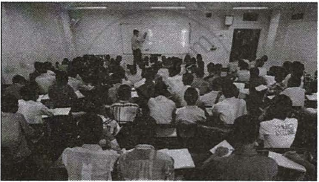Advertisements
Advertisements
प्रश्न
Find the value of k for which each of the following system of equations has infinitely many solutions
kx - 2y + 6 = 0
4x + 3y + 9 = 0
उत्तर
The given system of equation is
kx - 2y + 6 = 0
4x + 3y + 9 = 0
The system of equation is of the form
`a_1x + b_1y + c_1 = 0`
`a_2x + b_2y + c_2 = 0`
Where `a_1 = k, b_1 = -2,c_1 = 6`
And `a_2 = 4, b_2 = -3,c_2 = 9`
For a unique solution, we must have
`a_1/a_2 = b-1/b_2 = c-1/c_2`
`=>k/4 = (-2)/(-3) = 6/9`
Now
`k/4 = 6/9`
`=> k/4 = 2/3`
`=> k = (2xx4)/3`
`=> k = 8/3`
Hence, the given system of equations will have infinitely many solutions, if `k = 8/3`
APPEARS IN
संबंधित प्रश्न
Find the value of k for which the system
kx + 2y = 5
3x + y = 1
has (i) a unique solution, and (ii) no solution.
Find the values of a and b for which the following system of equations has infinitely many solutions:
2x - (2a + 5)y = 5
(2b + 1)x - 9y = 15
Solve for x and y:
9x - 2y = 108, 3x + 7y = 105
Solve for x and y:
`x/a + y/b = a + b, x/(a^2)+ y/(b^2) = 2`
Find the value of k for which the system of equations has a unique solution:
5x – 7y = 5,
2x + ky = 1.
For what value of k, the system of equations
x + 2y = 5,
3x + ky + 15 = 0
has (i) a unique solution, (ii) no solution?
2 men and 5 boys can finish a piece of work in 4 days, while 3 men and 6 boys can finish it in 3 days. Find the time taken by one man alone to finish the work and that taken by one boy alone to finish the work.
If `2 /x + 3/y = 9/(xy) and 4/x + 9/y = 21/(xy)` find the values of x and y.
Two straight paths are represented by the equations x – 3y = 2 and –2x + 6y = 5. Check whether the paths cross each other or not.
Read the following passage:
|
A coaching institute of Mathematics conducts classes in two batches I and II and fees for rich and poor children are different. In batch I, there are 20 poor and 5 rich children, whereas in batch II, there are 5 poor and 25 rich children. The total monthly collection of fees from batch I is ₹9,000 and from batch II is ₹26,000. Assume that each poor child pays ₹x per month and each rich child pays ₹y per month.
|
Based on the above information, answer the following questions:
- Represent the information given above in terms of x and y.
- Find the monthly fee paid by a poor child.
OR
Find the difference in the monthly fee paid by a poor child and a rich child. - If there are 10 poor and 20 rich children in batch II, what is the total monthly collection of fees from batch II?

